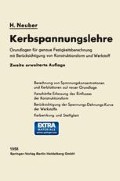Zusammenfassung
Um den Einfluß des Flankenwinkels verfolgen zu können, ist es zweckmäßig, den einfachen Schubspannungszustand zugrunde zu legen, wie er u. a. schon in der auf Drillung beanspruchten Welle aufgetreten war. Anläßlich der Frage der Entlastungskerben haben wir ebenfalls von diesem Spannungszustand Gebrauch gemacht und die zugehörigen Gleichungen bereits wesentlich vereinfacht, so daß hier die Beziehungen (1) bis (7) vom Abschn. VII übernommen werden können.
Access this chapter
Tax calculation will be finalised at checkout
Purchases are for personal use only
Preview
Unable to display preview. Download preview PDF.
Literatur
Landgraf, G.: Beiträge ;zur Kerbwirkung; Diplomarbeit 1952, Technische Hochschule Dresden.
Vgl. Fußnote 1 auf S. 178.
Author information
Authors and Affiliations
Rights and permissions
Copyright information
© 1958 Springer-Verlag Berlin Heidelberg
About this chapter
Cite this chapter
Neuber, H. (1958). Theorie des Flankenwinkels. In: Kerbspannungslehre. Springer, Berlin, Heidelberg. https://doi.org/10.1007/978-3-642-53069-2_9
Download citation
DOI: https://doi.org/10.1007/978-3-642-53069-2_9
Publisher Name: Springer, Berlin, Heidelberg
Print ISBN: 978-3-642-53070-8
Online ISBN: 978-3-642-53069-2
eBook Packages: Springer Book Archive

